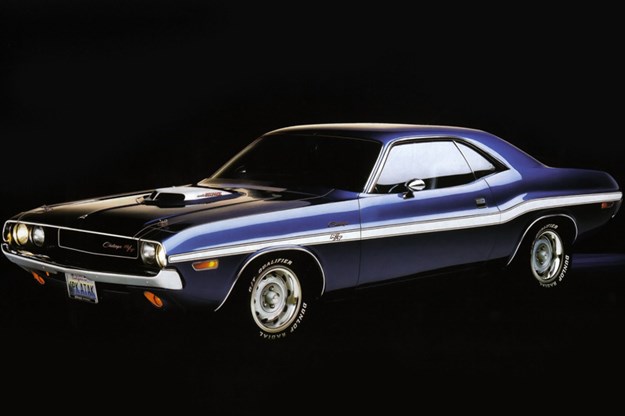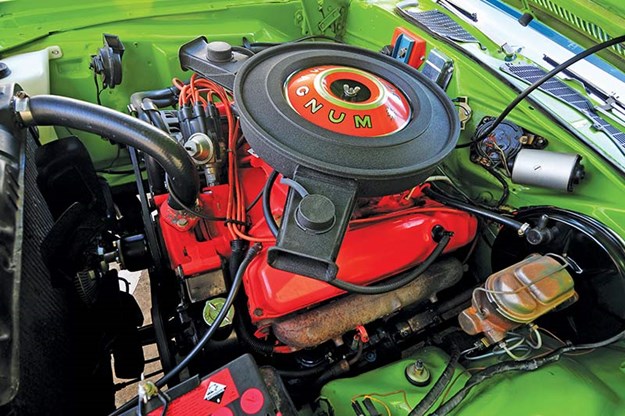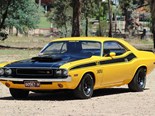1970-1975 Dodge Challenger - Buyer's Guide



|
An icon of the American muscle car movement. It will make a statement on Aussie roads, but later models lost their edge
Dodge Challenger
Whether by accident or intent, Chrysler Corp’s Mustang rival took ages to arrive. When it did, this car and its companion Plymouth ‘Cuda certainly ranked as worthy ‘challengers’ to the mega-selling Ford.
On its 2795mm wheelbase the Dodge version was more spacious than a ‘Cuda and more closely matched to the Mercury Cougar and Pontiac Firebird. Challengers did come with six-cylinder engines but hardly anyone wanted them and 87 percent of buyers during 1970 chose a V8.
These began with an engine familiar to Australian Chrysler owners; the 5.2-litre 318ci ‘Fireball’ and ran all the way to Chrysler’s potent 426ci Hemi.
Challenger buyers were offered their cars in two levels of trim - a basic Hardtop or convertible and the more upmarket SE. These weren’t the big sellers which Dodge dealers might have hoped them to be, with only 10 percent of Challenger production being SEs.

Those wanting sassy looks could upgrade to the R/T version with its ‘power bulge’ bonnet, distinctive striping, wheels and a full set of Rallye gauges decorating the dash.
| 2020 Market Review: Dodge Dart/Challenger/Viper/Ram SRT10
Very few big-engined soft-tops were sold and Hemi-powered Challenger convertibles are uncommon and expensive. Topping the list of recent US auction results was a four-speed manual SE Hemi, one of just five built in 1970, that set a new record when auctioned of US$1.43 million. The Challenger convertible disappeared completely after 1971.
Only slightly more common than a Hemi and still delivering prodigious performance was the R/T 440 with Six Pack (triple) carburettors. Back in the days when manufacturers could claim outrageous engine output figures, these engines were said to produce around 300kW, however they did certainly deliver with standing 400 metre times of less than 14 seconds.
1971 brought minimal change to the Challenger range but storm clouds were gathering. Sales figures plunged from 83,000 during the model’s introductory year to just 26,000 for 1971 and worse was to come.
By 1972 the Challenger was a dead duck. The mildly restyled Rallye came standard with the 5.2-litre V8, automatic transmission and just 126kW. There was an optional 5.9-litre engine but it was just a fuel guzzling lump.

Those with hopes of some performance from their Challenger could opt for a 5.5-litre 340 with manual transmission; an engine previously rated at 290 horsepower (215kW) but when strangled by emission controls it generated just 142kW.
| Reader Resto: 1970 Dodge Challenger
Decades ago it was hard for Australians to buy a Challenger without flying to the USA. Since the late 1990s the number of cars arriving has surged yet prices remain reasonable...
The Challengers most likely to be found in Australia will be base models with 6.3-litre (383ci) V8s and auto transmission. Some recently offered cars priced at $45-$60,000 were in only fair condition.
High-quality, Hemi-engined Challengers are virtually unknown here and will generate high prices if one does appear. Look to the USA for a car and you will be competing against local buyers who recently paid more than US$500,000 for a rare four-speed hardtop in ‘triple black’ - black body, vinyl roof and interior.
VALUE RANGE: Dodge Challenger (318/383 Coupe)
Fair: $18,000
Good: $36,000
Excellent: $55,000
(Note: exceptional cars will demand more)
BUYER'S CHECKLIST

Body & chassis
E Body Mopars weren’t paragons of build quality and even those that have never been crashed may display panel gap inconsistencies. If the bonnet and doors don’t fit properly, have the car checked for correct body alignment and bent rails. A car that has been ‘rotisserie’ restored will cost more than one that hasn’t been touched but over the longer term it will be worth more and demand less in maintenance. Rust attacks floors and the turret, also check window apertures and the rear pillars for bubbling plus floors, the lower door skins and sills. Bumpers are available at US$500 (plus freight) but replacing an R/T grille could cost $700.

Engine & transmission
Basic cars will likely have the 383 big block V8 which came to Australia in a range of models. Plenty of parts are available and rebuilding easy. Overheating is the big enemy so check for ‘milky’ oil, stains around hose connections and the water pump. Revamping the cooling system, including a new radiator, should cost around $1000. Sets of ‘Six-Pack’ carburettors with the correct manifold, linkages and gaskets are available ex-USA but allow A$4500 just for the parts, currency conversion and taxes. Manual cars are very rare indeed but the ‘727’ automatic transmissions used most often in these cars have a great reputation for durability. Be wary of an auto that shudders when downshifting.
Suspension & brakes
Mopar vehicles were for many years characterised by their torsion bar front suspension. The system is light and simple but as the bars age they can delaminate and metal around the mountings rusts. Creaks when u-turning or cracking noises from the front end over bumps are danger signals. For owners who want a car that handles more like a current model Challenger, complete replacement front ends are available that eliminate the torsion bars. They do cost several thousand dollars but are said to improve ride and lateral loadings and reduce weight. Cars with V8 engines generally have disc brakes already but conversion kits are available for those still running front drums.

Interior & electrics
Challenger cabin fittings and trim (in common with other models in its price bracket) were cheap and fairly nasty. Even the SE and RT were quite obviously being built to a price. Seats unless recently reconditioned may be sagging or split and the backs reluctant to lock in position. Replacement seat covers and foam padding are available but installation is a job for a professional unless you are experienced. New door cards to complete the job cost around $1000 per pair plus freight. Peeling plasti-wood trim, cracked dash plastics, door trims and armrests can be replaced but try to view a sample because quality varies between suppliers.
1970-1975 Dodge Challenger specs
Number made: 132,780 (approx) all models 1970-73
Body styles: Steel integrated body/chassis two-door coupe or convertible
Engine: 5211cc, 5565cc, 6275cc, 6974cc or 7206cc V8 with overhead valves and single or triple downdraft carburettors
Power & torque: 290kW @ 4800rpm, 529Nm @ 3200rpm (440 4bbl)
Performance: 0-96km/h 5.7 seconds, 0-400 metres 13.3 seconds (440 4bbl)
Transmission: Three-speed automatic, three or four-speed manual
Suspension: Independent with torsion bars, wishbones & anti-roll bar (f) live axle with semi-elliptic springs & telescopic shock absorbers (r)
Brakes: Drum or disc (f) drum (r) power assisted
Tyres: F70x14 bias ply
Unique Cars magazine Value Guides
Sell your car for free right here
Get your monthly fix of news, reviews and stories on the greatest cars and minds in the automotive world.
Subscribe

.jpg)

.jpg)










